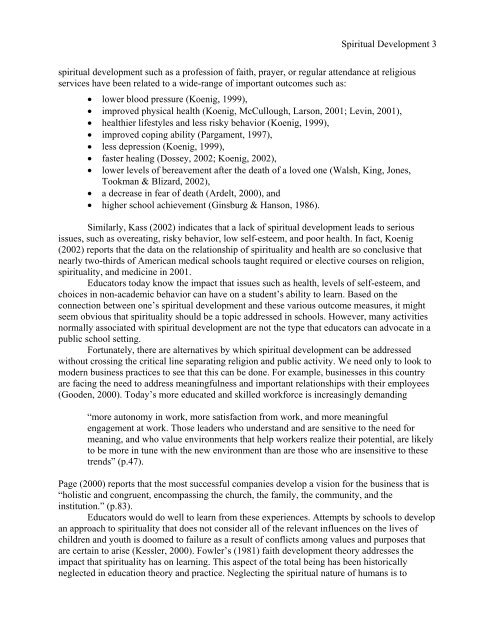The Gift of Spirituality
The Gift of Spirituality
The Gift of Spirituality
You also want an ePaper? Increase the reach of your titles
YUMPU automatically turns print PDFs into web optimized ePapers that Google loves.
Spiritual Development 3<br />
spiritual development such as a pr<strong>of</strong>ession <strong>of</strong> faith, prayer, or regular attendance at religious<br />
services have been related to a wide-range <strong>of</strong> important outcomes such as:<br />
• lower blood pressure (Koenig, 1999),<br />
• improved physical health (Koenig, McCullough, Larson, 2001; Levin, 2001),<br />
• healthier lifestyles and less risky behavior (Koenig, 1999),<br />
• improved coping ability (Pargament, 1997),<br />
• less depression (Koenig, 1999),<br />
• faster healing (Dossey, 2002; Koenig, 2002),<br />
• lower levels <strong>of</strong> bereavement after the death <strong>of</strong> a loved one (Walsh, King, Jones,<br />
Tookman & Blizard, 2002),<br />
• a decrease in fear <strong>of</strong> death (Ardelt, 2000), and<br />
• higher school achievement (Ginsburg & Hanson, 1986).<br />
Similarly, Kass (2002) indicates that a lack <strong>of</strong> spiritual development leads to serious<br />
issues, such as overeating, risky behavior, low self-esteem, and poor health. In fact, Koenig<br />
(2002) reports that the data on the relationship <strong>of</strong> spirituality and health are so conclusive that<br />
nearly two-thirds <strong>of</strong> American medical schools taught required or elective courses on religion,<br />
spirituality, and medicine in 2001.<br />
Educators today know the impact that issues such as health, levels <strong>of</strong> self-esteem, and<br />
choices in non-academic behavior can have on a student’s ability to learn. Based on the<br />
connection between one’s spiritual development and these various outcome measures, it might<br />
seem obvious that spirituality should be a topic addressed in schools. However, many activities<br />
normally associated with spiritual development are not the type that educators can advocate in a<br />
public school setting.<br />
Fortunately, there are alternatives by which spiritual development can be addressed<br />
without crossing the critical line separating religion and public activity. We need only to look to<br />
modern business practices to see that this can be done. For example, businesses in this country<br />
are facing the need to address meaningfulness and important relationships with their employees<br />
(Gooden, 2000). Today’s more educated and skilled workforce is increasingly demanding<br />
“more autonomy in work, more satisfaction from work, and more meaningful<br />
engagement at work. Those leaders who understand and are sensitive to the need for<br />
meaning, and who value environments that help workers realize their potential, are likely<br />
to be more in tune with the new environment than are those who are insensitive to these<br />
trends” (p.47).<br />
Page (2000) reports that the most successful companies develop a vision for the business that is<br />
“holistic and congruent, encompassing the church, the family, the community, and the<br />
institution.” (p.83).<br />
Educators would do well to learn from these experiences. Attempts by schools to develop<br />
an approach to spirituality that does not consider all <strong>of</strong> the relevant influences on the lives <strong>of</strong><br />
children and youth is doomed to failure as a result <strong>of</strong> conflicts among values and purposes that<br />
are certain to arise (Kessler, 2000). Fowler’s (1981) faith development theory addresses the<br />
impact that spirituality has on learning. This aspect <strong>of</strong> the total being has been historically<br />
neglected in education theory and practice. Neglecting the spiritual nature <strong>of</strong> humans is to

















